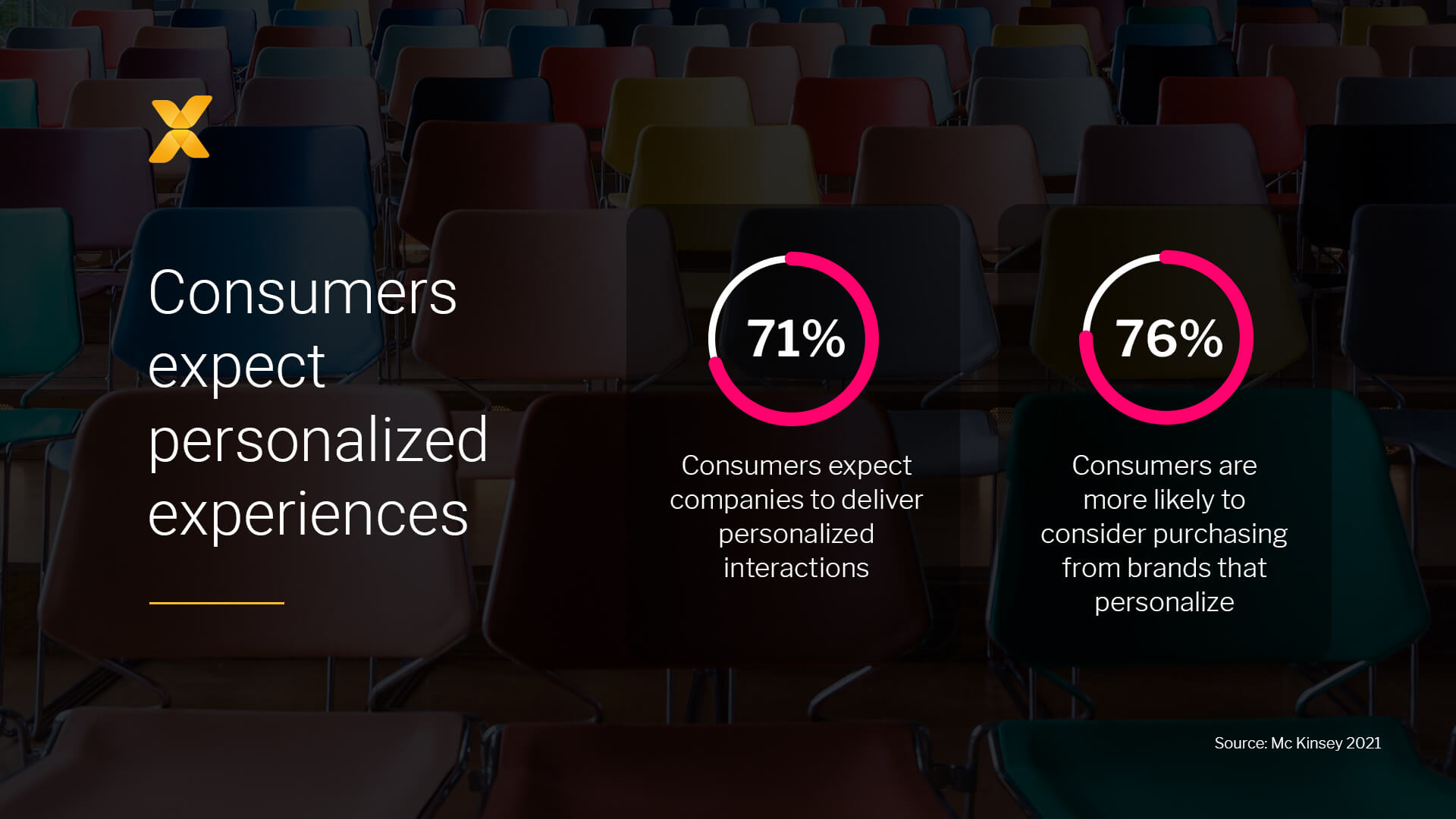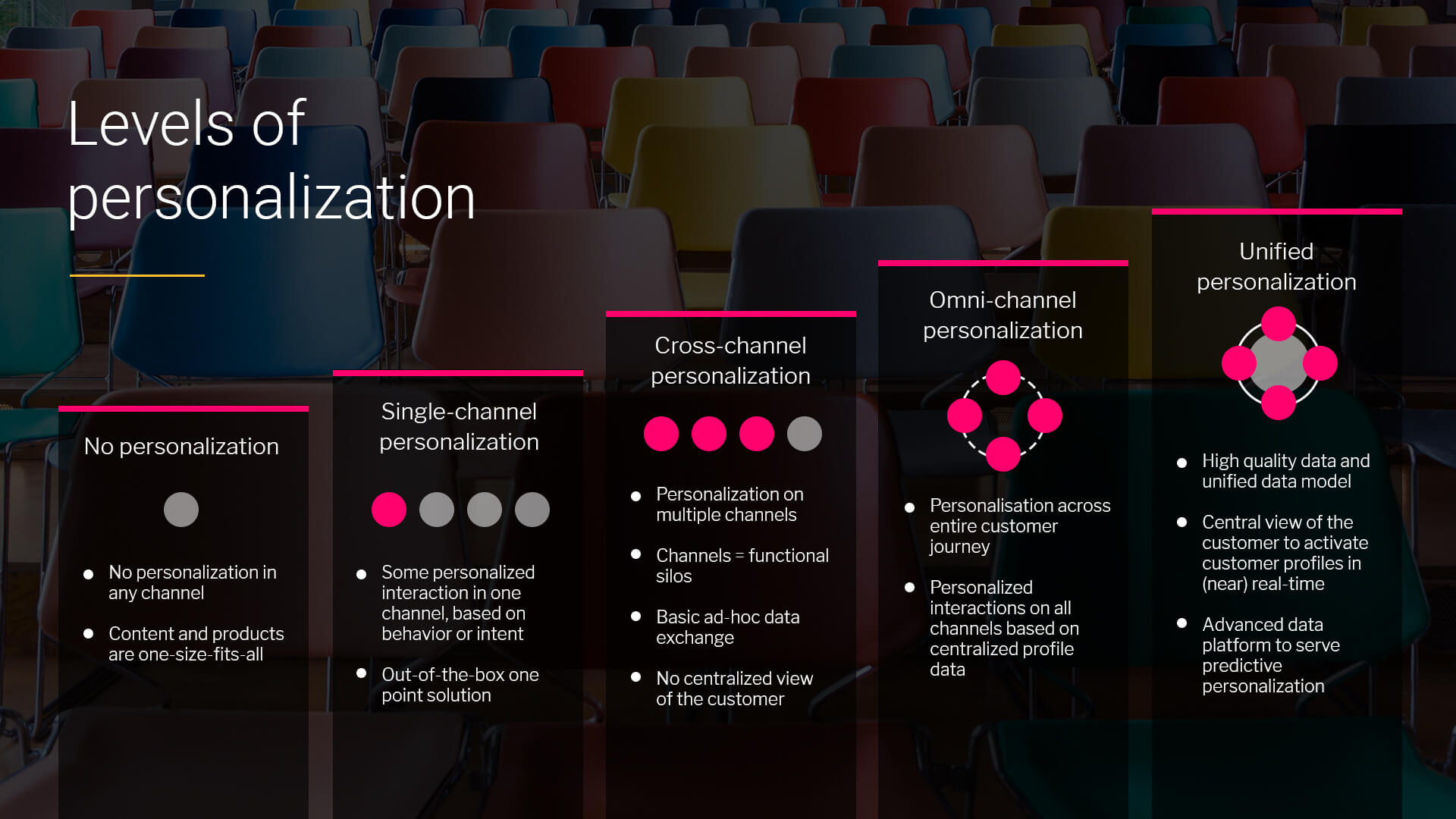In the face of an economic slowdown, the world of martech (marketing technology) is set to defy the odds and continue its growth. This growth is not only about increased spending but also about knowing where to invest to ensure your business’s expansion and meet the surging demand. At the event, speakers presented insights into what key elements you should have in your martech stack and how they contribute to building a more inclusive and effective customer experience through data and technology.
Table of contents
- Personalization at scale: A marketing director’s blueprint for success
- Other central themes from the event
- How Vaimo can help
Personalization at scale: A marketing director’s blueprint for success
In his speech, Steven Volders, Vaimo’s Global GTM Director – Customer Data, Insights & Activation, went through the building blocks of success with personalization in the highly demanding and evolving market.
Understanding the urgency of personalization in today’s market
 These days, consumers demand more personalized experiences than ever, and most will leave if they don’t get this experience. Consumers are also more likely to purchase from brands that offer personalized experiences.
These days, consumers demand more personalized experiences than ever, and most will leave if they don’t get this experience. Consumers are also more likely to purchase from brands that offer personalized experiences.
Personalization also has a positive impact on companies’ results; organizations that do personalization right increase revenue by 10 to 15%, and the real leaders even increase revenue by 25%. We can, therefore, conclude that personalization has value for both customers and companies.
For companies, it’s a journey to do personalization right. We identify several maturity levels of personalization that we discuss next. Are you wondering where you are with personalization and how to get to the next maturity stage? Then, definitely read on; we’ll clarify in the next sections.
Define your success and lead the change
 First, let’s introduce the five levels of personalization:
First, let’s introduce the five levels of personalization:
1. No personalization
2. Single-channel personalization
3. Cross-channel personalization
4. Omni-channel personalization
5. Unified personalization
As mentioned, personalization is crucial, and companies often have room for improvement in their level of personalization, so let’s look at how to start your journey.
- Vision & mission: You must define your vision and mission. For organizations, it may be very complex to transform from traditional ways of working to a fully optimized way while keeping the customers’ point of view in mind. It all starts with a clarified vision that gives you the direction. A challenge we often see is that omnichannel personalization forces you to work customer oriented and hence across the traditional organizational silos. This requires a common vision & ambitions, supported by the executive team, to drive the change.
- Objectives, roadmap, and key results: Next you need to make your vision more specific to ensure your strategic vision finally translates into operational ‘instructions’ or ‘guidelines.’ We do that by defining clear objectives & the key strategic pillars to achieve them, giving high-level direction to the whole organization.
By defining key results (smart goals) for each objective you clarify the direction for the specific operational teams. How exactly they achieve this is less important at this stage: they should have the freedom, to some extent, to experiment and learn, but always have these high-level objectives in mind. Evaluate the key results on a quarterly or even monthly basis to assess your performance.
These are some foundational steps to prepare for the change, which can be quite a transition. But change doesn’t happen by itself, so you must have the right things in place to lead the change.
Here’s how you can do that:
- Establish a sense of urgency: Make sure there is a sense of urgency in the organization to avoid falling back to previous ways of working. One way to do this is to have a bold ambition, which means that if we want to double our revenue growth, we cannot continue to do the same thing that we were used to in the organization – we need to change; we need new strategies, tools, processes and ways of working.
- Steering your team to lead the change: It’s essential to have a guiding coalition to help the change move forward. One person with a solid vision to move forward isn’t enough: you need to have people around to drive the change, even in difficult times. Get a healthy mix of leaders & managers in that coalition.
- Communicate the vision: Communication is a permanent key to the whole transition. Communicate the vision and why certain things have to be done.
- Empower & eliminate obstacles: For example, if you have recently implemented a new marketing automation tool that doesn’t fit your vision, you may need to move forward. This may not be your first step, but remember to look at your vision as a whole and not use tools that don’t fit your vision.
- Generate short-term wins, but don’t celebrate victory too soon: Quick wins can help to keep the team motivated, but avoid celebrating victory too soon. Keeping a sense of urgency is essential to help the organization shift into this new reality.
The winner’s manual: How to prepare and succeed with personalization at scale
Here are the key takeaways to succeeding with optimization and personalization at scale:
1. Define your purpose. Dream big, start small.
You can dream big and start small, but keep the long-term vision in mind. Don’t focus too much on the short-term fixes or current limitations because they will only take you so far, and they may not help you reach your bold vision.
2. Keep a single view of customers and products
Ensure you have a single view of the customer and a single view of products. Make sure you have the right solutions in place to achieve these ambitions and don’t forget to have the right processes and people in place to make things happen and succeed.
Do you want to know how to master your customer experience facilitated by centralized customer data? Explore how a CDP can help you to understand better and leverage your customer data for omni)channel personalization.
3. Future-proof your platform for optimization at scale
Make sure you have a future-proof platform for optimization at scale; in other words, don’t focus only on the short term (e.g., quick integrations) but have the right platform in place to achieve long-term goals, ready to scale.
4. See personalization as a part of a continuous process for improvement
Focus on delivering value streams to your customers with cross-functional teams.
5. Embrace the culture of failure
Objectives might be fixed, but the way to get there should be flexible. This means the operational teams should be allowed to fail, and it’s okay as long as they learn from it.
A Customer Data Platform (CDP) offers a unified customer view and allows you to focus on organization-wide user experiences. Learn more about CDPs and download our free ebook »
Other central themes from the event
The imperative of a robust martech ecosystem
To thrive in the ever-evolving martech landscape, building a robust martech ecosystem is essential. Your martech stack should be carefully curated to align with your business objectives and growth strategies. In a climate of economic uncertainty, your martech choices are critical in staying ahead of the curve.
Data-driven decision making
One of the primary keys to success in 2023 and beyond is the intelligent use of data. By harnessing the power of data analytics and real-time insights, you can create hyper-personalized marketing campaigns that resonate with your target audience. It’s time to bid farewell to one-size-fits-all marketing and embrace a more personalized, data-driven approach.
Real-time engagement
Today’s consumers expect real-time engagement. Martech solutions that facilitate immediate, personalized interactions are indispensable to meet these expectations. Real-time engagement not only enhances the customer experience but also allows businesses to respond promptly to changing market conditions.
Consistency across all touchpoints
Maintaining a consistent customer experience across all touchpoints is crucial for retaining and growing your customer base. Your martech stack should enable you to deliver a unified message and experience, whether a customer engages with your brand on your website, social media, or via email.
Despite economic challenges, martech spending is poised for continued growth in 2023 and 2024. To make the most of this growth, focus on building a solid martech ecosystem, leverage data for personalized marketing, enable real-time engagement, and maintain a consistent customer experience.
How Vaimo can help
With our team of senior industry experts, we can guide you and your organization to help you clarify the vision and ambitions and translate that into an actionable plan & roadmap to gradually mature on all key capabilities following our proven framework:
- Purpose (Vision & objectives)
- Performance (Objectives & Key results)
- Processes (e.g., to understand & optimize the customer journey)
- People (roles, training, culture)
- Platform (tools, data)
We have the experts in place to strategize, define, implement, operate and educate to assist your organization in such a transformation.
Do you need specific guidance to further navigate in the martech space? Look at our self-assessment tools for CDP, Headless CMS, and PIM to find out where you stand in those domains and if you would benefit from those solutions. Or contact us to get started right away.







